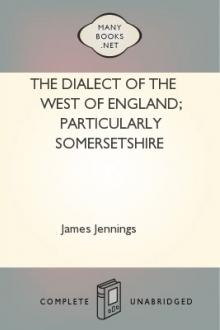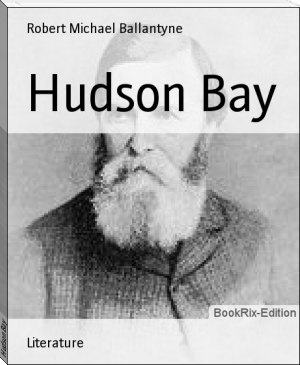Handbook to the new Gold-fields, R. M. Ballantyne [mobi reader android .TXT] 📗

- Author: R. M. Ballantyne
Book online «Handbook to the new Gold-fields, R. M. Ballantyne [mobi reader android .TXT] 📗». Author R. M. Ballantyne
“The voyage from San Francisco to Vancouver’s Island, which in a steamer is made all the way within sight of the coast, is one of the most agreeable when the voyager is favoured with fine weather. I know none other so picturesque out of the Mediterranean. The navigation is so simple that a schoolboy could sail a steamer, for a series of eighteen headlands, which jut out into the ocean all along the coasts of California, Oregon, and Washington Territory, served as landmarks to direct the mariner in his course. All he has to do is to steer from one to another; from Point Reyes outside the Golden Gate to Point Arena, the next in succession, and so on till he comes to Cape Flattery, upon rounding which he enters the Straits of Fuca, towards the end of his voyage.
“The northern portion of the coast of California and the whole length of the coasts of Oregon and Washington are thickly wooded. In fact, this vast stretch of country is one continuous pine forest. From the shore, where the trees dip into the sea, back to the verge of the distant horizon, over hills, down valleys, across ravines, and on and around the sides and tops of mountains, it is one great waving panorama of forest scenery. Timber—enough to supply the wants of the world for ages, one would think. Yet the broken character of the country relieves the scene from monotony, and it fully realises the idea of the grand and the beautiful combined. One spot in particular made an impression upon me which I wish I had the power to convey by words. Between Cape Mendocina and Humboldt Bay, on the northern limits of California, a grand collection of hills and mountains of every variety of size, shape, and form occurs. This grand group recedes in a gentle sweep from the coast far inland, where it terminates in a high conical mountain, overtopping the entire mass of pinnacles which cluster around it. The whole is well clothed with trees of that feathery and graceful foliage peculiar to the spruce and larch, and interspersed with huge round clumps of evergreens, with alternations of long glades and great open patches of lawn covered with rich grass of that bright emerald green peculiar to California. This woodland scene, viewed of an early morning, sparkling with dew-drops under the rising sun which slowly lifted the veil of mist hanging over it, surpassed in beauty anything I have seen on this continent. Here everything in nature is on a grand scale. All her works are magnificent to a degree unknown in Europe. A trip to these regions will pay the migratory Englishman in search of novelty to his heart’s content, and I will bear the blame if he is not well pleased with his journey. California alone should satisfy a traveller of moderate desires. Here he will find combined the beauty and loveliness of English landscape with the bolder and grander features of the scenery of the Western continent—a combination, perhaps, unequalled in any other country. On this, the northern coast, the bold and the picturesque predominate over the tamer park-like scenery of the interior valleys, which so nearly resemble the ‘fine old places’ of England.”
Another route, which it is proposed to open on the other side of the country, from Minnesota to the Fraser River gold mines, would appear to be very feasible. From Saint Anthony the Mississippi is navigable for large steamers as far as the Sauk Rapids. Thence to Breckenridge, at the head of the navigation of the Red River of the North, is a distance of 125 miles. This part of the journey must be made overland; but already this district is being fast occupied by settlers, and a good road may easily be constructed. At Breckenridge a settlement has also been established. Here commences the fertile valley of the Red River, and from this point, as appears from Captain Pope’s survey, the river, which runs due north, is navigable for steamers all the way to its mouth, at the southern extremity of Lake Winnepeg. It begins with four feet of water, and gradually deepens to fifteen feet Lake Winnepeg, which is long, narrow, and deep, receives near its northern end the Saskatchewan, flowing from the west, and having its sources in the Rocky Mountains. The river, and the country on its banks, have recently attracted attention as well fitted for colonisation. Taking the climate of the eastern portion of the continent, and of the region round Hudson’s Bay, as a standard, it was long supposed that all the interior of North America, beyond the 48th or 49th degree of north latitude, was too cold to produce grain crops; and unfit, therefore, for the habitation of civilised men. Recent investigations, however, have fully established the curious and very important fact, that west of the western end of Lake Superior, at about the 100th degree of west longitude, a remarkable change begins to take place in the climate; to such an extent, that as we proceed westward the limit of vegetable growth, and of the production of grain, is extended far to the north, so as to include the whole valley of the Saskatchewan, which is represented as in other respects well fitted for settlement. The Saskatchewan is a river larger and longer than the Red River of the North; and, according to Governor Simpson, of the Hudson’s Bay Company’s Service, in his notes on its exploration, it is navigable by its northern branch, with only one rapid to obstruct navigation, for seven hundred miles in a direct line to the foot of the Rocky Mountains. How serious an obstruction this may be does not clearly appear. It can hardly be a perpendicular fall, since, according to Governor Simpson, canoes and flat-boats pass over it in safety. From the head of navigation it is only about two hundred miles across the Rocky Mountains, of which the elevation here is much less than in Oregon and California, to the Thompson and Fraser Rivers.
The distance from Breckenridge to the mouth of the Red River is estimated at 450 miles. Thence through lake Winnepeg to the mouth of Saskatchewan is 200 miles. Allowing for windings, the navigation by that river may be set down at 1000 miles. Add 125 miles of land carriage at one end of the route, and 200 at the other, making in the whole a distance of about 2000 miles, from the starting point on the Mississippi.
So fully impressed are some enterprising people of Minnesota with the practicability and advantage of this route, that measures have been already taken for building a steamer at Breckenridge, designed to navigate the waters of the Red River, Lake Winnepeg, and Saskatchewan, and to be ready for that purpose by the opening of next spring. Meantime as the greater part of the route is within the territories of the Hudson’s Bay Company, steps have been taken to open a communication with the Governor of that Company, and with other persons likely to assist in putting a line of steamers on these waters.
At present various measures are being taken by the Canadians to shorten this last route, and apparently with much success. They are making arrangements for passing around the headwaters of Lake Superior, and thus saving the détour in Minnesota. In a very short time it is said that an easy and inexpensive means of communication will be formed between Canada and the gold-fields; but, for the present, the Panama route is decidedly the preferable one for British emigrants.
The Pacific coast extends from Panama westward and northward, without any remarkable irregularity in its outline, to the tropic of Cancer, almost immediately under which is the entrance of the great Gulf of California, separating the Peninsula of California from the main continent on the east. From the southern extremity of this peninsula the coast runs generally north-westward to Mount Saint Elias, a lofty volcanic peak, rising from the shore of the ocean under the 60th parallel, beyond which the continent stretches far westward, between the Pacific on the south, and the Arctic Sea on the north, to its termination at Cape Prince of Wales, in Behring’s Straits, the passage separating America from Asia. The part of the coast south of the 49th degree of latitude (the American boundary) presents few indentations, and the islands in its vicinity are neither numerous nor large. North of the 49th degree, on the contrary, the mainland is everywhere penetrated by inlets and bays; and near it are thousands of islands, many of them extensive, lying singly or in groups, separated from each other and from the continent by narrow channels.
From the mouth of the Columbia forty-five miles of unbroken coast reaches Whidbey’s Bay, called by the Americans Bulfinches Harbour, and not unfrequently Gray’s Bay, which, with an entrance of scarce two miles and a-half, spreads seven miles long and nine broad, forming two deep bays like the Columbia. Here there is secure anchorage behind Point Hanson to the south and Point Brown to the north, but the capacity of the bay is lessened to one-third of its size by the sand banks which encroach on it in every direction. Like the Columbia, its mouth is obstructed by a bar which has not more than four fathoms water, and as it stretches some three miles to seaward, with breakers on each side, extending the whole way to the shore, the difficulty of entrance is increased. It lies nearly east and west, and receives from the east the waters of the river Chikelis, having its rise at the base of the mountains, which, stretching from Mount Olympus in the north, divide the coast from Puget’s Sound. From Whidbey’s Bay to Cape Flattery, about eighty miles, but two streams, and those unimportant, break the iron wall of the coast, which rising gradually into lofty mountains is crowned in hoary grandeur by the snow-clad peaks of Mount Olympus. Cape Flattery, called also Cape Classet, is a conspicuous promontory in latitude 48 degrees 27 minutes; beyond it, distant one mile, lies Tatouches Island, a large flat rock, with perpendicular sides, producing a few trees, surrounded by rocky islets: it is one mile in length, joined to the shore by a reef of rocks, and a mile further, leaving a clear passage between them, is a reef named Ducan’s Rock. Here commences, in latitude 48 degrees 30 minutes, that mighty arm of the sea, which has been justly named from its first discoverer, the Strait of Juan de Fuca, and which Captain Cook passed without perceiving. The entrance of this strait is about ten miles in width, and varies from that to twenty with the indentations of its shores, of which the northern, stretching to the north-west and south-east across the entrance, gives an appearance of continuity to its line on the Pacific. Running in a south-easterly direction for upwards of one hundred miles, its further progress is suddenly stopped by a range of snow-clad mountain, at the base of which, spreading abroad its mighty arms to the north and south, it gives to the continent the appearance of a vast archipelago.
Of the Straits of Fuca and surrounding shores, the latest and fullest information we possess is that contained in the letter of the Times’ special correspondent, published on 27th August. He says:—
“We have now rounded Cape Flattery, and are in the Straits of Fuca, running up between two shores of great beauty. On the left is the long-looked-for Island of Vancouver, an irregular aggregation of





Comments (0)